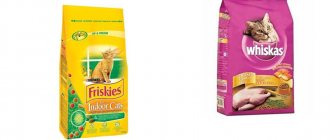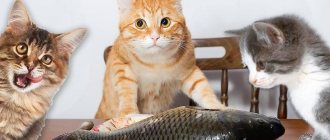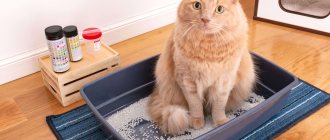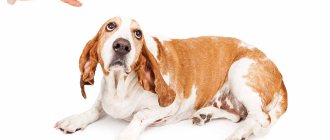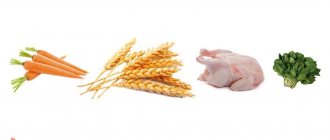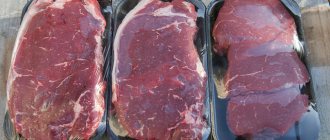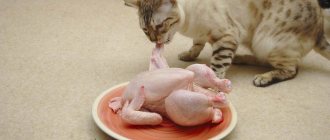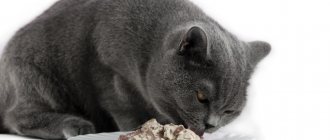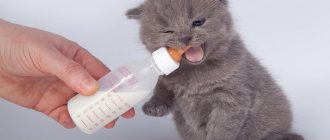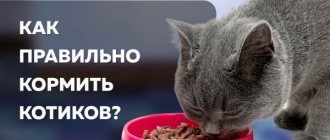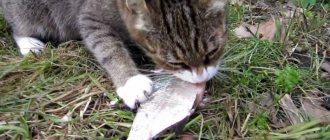Content
1. Beneficial properties of buckwheat 2. Are there any restrictions on feeding 3. How much buckwheat does a cat need 4. How to prepare and give it correctly
In nature, hunting cats eat grains along with meat. Together with the caught bird or mouse, the grains of the cereals on which they ate enter the animal’s body. A complete diet when feeding natural food to domestic cats includes the introduction of cereals. Cereals supplement the cat's diet with vitamins and microelements. Therefore, it is advisable to introduce cereals into the diet of domestic cats, or rather, porridge made from them.
However, not all grains are good for cats. The list of prohibited foods includes barley, semolina, millet, peas, and corn. Cat nutrition experts categorically prohibit feeding them to their pets. These grains harm the health of animals and provoke various diseases.
At 1.5 months
Below we will consider how and what to feed a 1.5 month old kitten at home:
At this age, the pet can already feed on its own, and its diet should be balanced. At this age, the kitten can be fed:
- rolled oats and buckwheat porridges;
- vegetables (any vegetables, except potatoes, served boiled or raw);
- raw meat (low-fat varieties). Served raw, boiled or scalded with boiling water. Meat products make up from 60 to 80% of the total daily food volume.;
- boiled offal;
- cottage cheese - 30 g per day, preferably not fatty;
- raw fish, previously doused with boiling water (about 1 time every 7 days);
- greens (you can ask at the animal department).
How often should I feed?
Kids eat a lot, 5-6 meals a day is the norm. In general, a kitten should eat 120 g per day. The baby cannot eat this amount at once. If the kitten eats less than normal, then you should try changing the food. If the animal refuses food, it is better to contact a veterinarian.
Once the kitten reaches 2 months, you can feed it a little more - up to 180 g
At this moment, it is important to monitor the pet’s activity - more playful and active animals need more food.
If you are going away for the day and leaving your kitten alone, feed him before you leave and leave some food in his bowl and feed him more when you return.
Food additives
Do not neglect this important point - vitamins and supplements will have a beneficial effect on the kitten’s body.
From 1.5 months you can add to food:
- Kitzim;
- "Doctor Zoo";
- "Brevers";
- "Farmavit";
- "Biofar".
Before purchasing vitamins, consult with specialists. Veterinarians can advise you on which food supplements are best for your pet and whether your pet needs them at all. The most popular supplement for cats is fish oil. Veterinarians advise giving it 2 capsules for 7 days.
What not to give to a kitten
Every caring owner should remember the list of prohibited foods. Kittens should not eat:
- food with spices (the kind that people like);
- fatty meat: pork, beef;
- human medicines;
- sweets;
- river fish;
- legumes;
- fatty dairy products;
- flour;
- potatoes.
Is it possible to have ready-made food at 1.5 months?
Cat owners and veterinarians do not recommend mixing food and natural food. Many people primarily purchase ready-made cat food for a number of reasons:
- saving time;
- nutritional balance.
If you want to feed your pet food, you should consider that:
- it will not be possible to switch to natural nutrition;
- You cannot mix food of different brands, as they contain different microelements;
- Only high-quality commercial feed is suitable for feeding.
Choose high-quality, balanced food and your kitten will not have any health problems.
Kittens love wet food, but it's a little more expensive. However, according to veterinarians, dry, high-quality ones are more useful.
It is worth noting that wet food contains about 80% water, and your pet does not need to constantly drink water. With dry food, everything is different - there should always be a clean bowl with drinking clean water near the food bowl.
Veterinarians consider the following brands to be good food:
- Royal Canin;
- Almo Nature;
- Pro Plan Junior;
- Eukanuba Puppy Kitten.
The price tag may scare the kitten's owners, but believe me, by purchasing good food, you only win. You won’t have to buy additional vitamins, and the kitten will be healthy, and you won’t have to spend money on treatment.
Beneficial properties of buckwheat
Veterinarians unanimously recognized buckwheat as the most valuable and safest cereal crop for cats and recommend regularly feeding porridge from it to pets. Buckwheat is rich in nutrients. It contains:
- vegetable proteins;
- cellulose;
- organic fatty acids – oxalic, citric, malic;
- B vitamins;
- tocopherol (vitamin E);
- niacin, or nicotinic acid (vitamin PP);
- trace elements (iron, iodine, zinc, cobalt, phosphorus, molybdenum, potassium, copper);
- many other substances beneficial to the body.
For normal life, cats need all the components contained in buckwheat. Animal proteins are considered the best for pets; plant proteins are less digestible. In addition, they lack essential amino acids, but a small amount of protein (13%) does not impair the nutritional value of buckwheat for animals. But it is a leader among other cereals in terms of iron content and fully satisfies the animal’s body’s needs for this microelement. Pets need iron for the normal functioning of the circulatory and cardiovascular systems.
In addition to iron, cereal contains trace elements no less important for cats - iodine (its deficiency provokes dysfunction of the thyroid gland, hair loss, weight gain), zinc (responsible for metabolic processes in the body, contains about 200 enzymes involved in cell division, promotes correct functioning smell and taste receptors - which is very important for a furry hunter!), other minerals. Buckwheat contains folic acid, which increases the animal’s endurance and resistance to various diseases and plays an important role in the process of hematopoiesis.
Important!
Buckwheat is easily digestible, does not irritate the cat’s digestive system and gastrointestinal tract, and does not cause allergic reactions.
How to cook?
To make buckwheat as beneficial as possible for your pet, it is important to choose and prepare it correctly. To feed your pets, you can take both the kernel and the chaff. But you cannot use instant porridge. They contain many foreign impurities.
Cereals can be cooked in water, milk, meat or fish broth . The main rule is that it is advisable to give milk porridge only to kittens up to about six months of age. Young animals absorb lactose from milk well. But with age, this ability is lost. And excess calcium can provoke urolithiasis.
For adults, cereals cooked in water or natural broths from fish and meat are more suitable. They shouldn't be too strong. Do not use salt or other spices, especially hot ones. When cooking fish broth, you need to make sure that there are no bones left in it after cooking. Therefore, it is better to strain the composition through a sieve.
The porridge should be boiled well. It should be semi-liquid so that the cat can eat it comfortably. To improve the taste, you can add a small amount of natural butter or odorless vegetable oil to the slightly cooled complementary food.
Meat and other additives
For flavor, you can add finely chopped or minced lean boiled meat or fish to the finished dish in a 1:3 ratio.
In addition, you can mix buckwheat with 1-2 tbsp. l. canned meat intended for cats. To increase nutritional value, experienced owners of these animals recommend mixing homogenized baby meat puree into the finished porridge. But in small quantities, since it may contain sugar, salt or other additives.
If possible, you can add boiled offal (heart, liver, kidneys) in boiled and crushed form to the cereal. They contain many useful substances, are nutritious and easily absorbed by the cat's body.
To diversify your diet, you can add boiled boneless fish to buckwheat. But canned food intended for human consumption is not suitable for this purpose.
Some experts advise adding hard-boiled eggs to the porridge - half for 1 serving. You can use both the white and the yolk separately.
Some cats like buckwheat mixed with herbs or vegetables. It is quickly absorbed and activates the gastrointestinal tract.
You should try several cooking options. And choose the one that your pet will like the most.
Are there any feeding restrictions?
Despite its safety, not all cats are suitable for buckwheat. Before introducing a product into a cat's diet, it is necessary to take into account its health status. Only after positive recommendations from a veterinarian can you introduce porridge into the diet if your pet has the following diseases:
- oncological;
- autoimmune;
- tendency to allergic reactions.
It would not hurt to consult a specialist if the cat is old or young. It is known that some pets may have individual intolerance to the product, although buckwheat porridge is considered a hypoallergenic food.
Important!
If a cat, according to the veterinarian's indications, takes vitamins and microelements, then buckwheat should be excluded from the diet, since an excess of these substances can adversely affect the health of the animal.
Secrets of a cat's diet
In order for your animal to be healthy and active, you must follow certain feeding rules. For example, under no circumstances should you mix dry food with natural food. If you feed your cat both natural and ready-made food, then make sure that the interval between feeding is at least six hours.
It is necessary to accustom an animal to cereal crops in infancy. If the reason for switching the animal to porridge was forced, pureed fish or meat and vegetables should be added to the prepared porridge to enrich the diet.
To summarize, we can safely say that buckwheat in a cat’s diet is a healthy product. The only thing is that when starting to feed your cat buckwheat porridge, you need to start with small portions. However, this recommendation applies not only to buckwheat, but also to any new complementary food for pets.
By strictly following all of the above nutritional recommendations, you can ensure your pet has a long and healthy life.
Source
How much buckwheat does a cat need?
If your cat is healthy, then feel free to add buckwheat porridge to its menu. However, when compiling it, you need to take into account that the cat is a predator, so you cannot feed it only cereals. An animal needs meat, grains, and vegetables. A plant-based menu with a lack of animal food can cause disturbances in the intestinal microflora, diseases of internal organs, obesity and a decrease in the body’s immune defense. Therefore, a balance of meat and grains is necessary.
The optimal ratio of buckwheat and meat in the diet is 1:3. The frequency of feeding a cat buckwheat porridge is no more than once every two days. As a percentage, cereals should make up no more than 20% of the pet’s total diet.
Several recipes
Chicken with rice and vegetables
- Boil 2 small carrots in a separate container and then grate them.
- Cook chicken thighs in a small saucepan. When the meat is boiled, you can add brown rice to the broth.
- While the rice is cooking, you can cut the chicken into small pieces.
- When the rice is cooked, let it cool slightly.
- Take one part of rice and mix with the same amount of chicken.
- Add some grated boiled carrots on top, now you can serve the dish.
Buckwheat porridge with stewed meat
- Buy a good stew at the store; it’s better to buy several cans at once, as some may not contain meat.
- Add a pinch of salt to the water, and after boiling, throw in the stew.
- When our broth boils, we can add buckwheat.
- The dish can be added only after it has cooled. We also recommend adding vegetables to the porridge; to do this, you can boil the beets in the microwave and then finely chop them.
Cooking porridge
In addition to finding out what kind of porridge can be given to cats, you also need to figure out how to prepare it correctly? It is recommended to cook it in meat broth for as long as possible so that it is thoroughly boiled. It is important to consider the proportions so that the porridge is not thick, but more viscous.
How many days before vaccination should a cat be given anthelmintic?
When cooking cereals, it is forbidden to add spices or sugar; you can only add a little salt. Cats still cannot distinguish the taste of spices, and they only bring harm to the animal’s body.
Advice! It is recommended to mix porridge with fish or meat. But fish should be given no more than twice a week. It is advisable to choose boneless and non-greasy.
Below are several simple and healthy recipes for making porridge for cats of different breeds, including Scottish.
Porridge with vegetables
For cooking you can use rice, buckwheat or pearl barley. You will also need 1 boiled carrot and finely chopped chicken meat. All ingredients are thoroughly mixed and served to your pet.
Rice porridge with salmon
Boil the rice until cooked and has a sticky consistency. Add some finely chopped fish and hard-boiled eggs to the porridge.
Rice porridge with salmon
Porridge with broccoli and chicken
You can use any cereal. Boil it in chicken broth until tender. Separately, steam the broccoli and then chop it. Mix all ingredients well.
Beef liver porridge
Boil the cereal until tender, add a pinch of green peas, a few pieces of boiled meat and a little vegetable oil. The animal will definitely appreciate the prepared dish.
If you follow these recipes, you can quickly accustom your pet to proper and healthy food, rich in vitamins and microelements.

